#lowland curb
Text

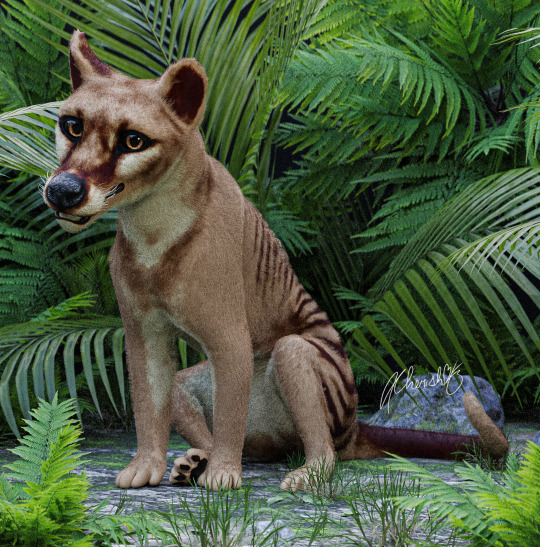

Dreaming, 2023
Art Fight of curbs by CherishLoveArt. Rigged and animated from scratch! Curbs are fantasy thylacines that pop up in @alhilton's wonderful novel Hunters Unlucky. With permission, I entered my own version of the curbs in Art Fight this year. Absolutely blown away by the wonderful art I received!
#Art Fight#Art Fight 2023#CherishLoveArt#Hunters Unlucky#Abigail Hilton#curb#speculative biology#thylacine#lowland curb#highland curb
1K notes
·
View notes
Text
I'm rapidly catching up on the past 200 years of the Fort Meigs area. Even more so than Captain Marryat in his 1830s travelogue A Diary In America, I'm surprised at how much things have changed since 1814.

In scenario A (year 1810), you can see the corduroy road over the swampy lowland, soon to be transporting men in cute Napoleonic-style military uniforms and supplies to Fort Meigs. The world is in balance, as represented by the ghost sharks in Lake Erie.
In scenario B (year 2010), the wetlands have been drained and replaced with corn, causing a great evil to manifest in the area. Excessive corn has driven away the ghost sharks and replaced them with green slime. And there's a Toledo (not the one in Spain).
In scenario C (year 2050), successful ecological restoration of the landscape has placed a barrier of wetlands between the corn and bodies of water and curbs the malign influence of Toledo. Ghost sharks have returned to Lake Erie, and the world is in greater harmony (as shown by the lack of green slime).
(It's a real academic journal article, btw.)
#great lakes#lake erie#ohio#war of 1812#fort meigs#maumee river#wetlands#great black swamp#if i'm really lucky i'll relocate here for a job 🙏🏻#altho the slime is concerning#reading more on this is fascinating
12 notes
·
View notes
Text
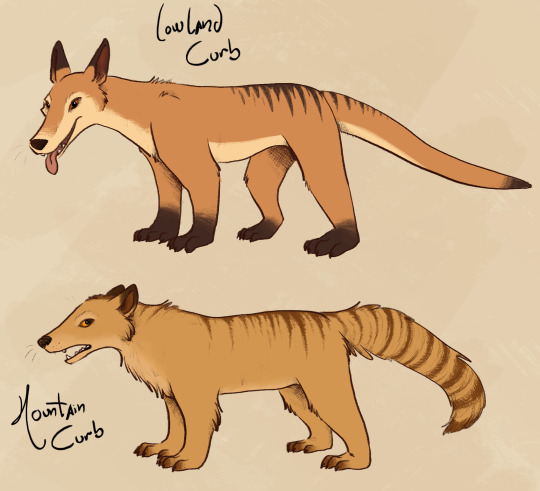
The curbs!!! i imagined them as weird foxes until the moment we learn they're marsupials, and realized they were supposed to be more thylacine-like, so i had fun and gave the lowland curbs somewhat fox-like markings and colors Just Because. The mountain curbs have shorter limbs, ears and noses + thicker fur, making them better equiped to survive in, well, mountains and colder temperatures.
Kinda jumped off @tunagriff 's idea of giving them lil grabby hands (which is just excellent!) and made them plantigrades too. It'd give them an interesting gait, i just thought it'd be neat :p
#Hunters unlucky#i really like the idea of both species having a wider range of fur colors that kinda overlap?#so it's mostly red/brown/pale sandy fur#but the species could look similar from a distance#flashbic draws stuff
48 notes
·
View notes
Text
3850 BE, DAWN ERA
News travels fast through the river system, an invasion from the mountains that the Urifum peoples could not hold up against, and foreign barbarians are flooding down into the lowlands as a horde, the Urifum people arriving beforehand as harbingers of destruction beforehand, creating crisis after crisis as cities are swarmed with refugees from mass pillages, not only do cities have to deal with this new instability, but also lay in fear of a new existential threat.
Not everyone has to worry about the east however, the Orachim people of the western cities send out dozens of mercantile voyages downstream in search of trade partners, and they found plenty along the agriculturally wealthy Q'abiru city states, including the Asanid gates themselves, bringing exotic crop back north for fine dining and cultivation, in exchange for crafted goods delivered, as well as improving trade links and relations across the region, recieving info on profitable trade routes from now friendly Asanid merchants.[ShockedBread's Orachim]
The eastern Orachim however, settled in Chalakaw, instead spend time developing their craft and tools with alloy experimentation, comparisons and general metallurgy innovation taking place, but that was nopt the onl focus, as a few envoys similarly ended up in Asanid, or even Kanshu to learn the secret of the written word, perhaps to take it for mercantile purpose, perhaps for diplomacy, maybe even for administration. But written language spreads to yet another peoples, following in the steps of religion.[Pfysche's Orachim]
While the farming boom dies down due to the unsustainablility, people return to more skilled professions in the city, but also wish for a standardised method of teaching. For this purpose, many master craftsmen, artisans and other such skilled people have set up classes to teach apprentices en mass theory and practical training in certainskills as a future investment in the community to curb the unstable state of workforce distribution, though that may be solved in place of a new problem. Refugees, a lot of them are now around the city, claiming to be harbingers of a force of great force and destruction, and requesting asylum.[Inferno's Internostri]
Further down south however, similar advances are made by the same peoples, but in different settings. The transmigratory tribes have finally drawn near to the source of the myth of Aevum, but find themselves at the entrance of an unfamiliar culture, no doubt speaking of the same myth and the same dawn the whole region has seen and been attracted to, but the negotiations to go further are as of yet, unclear. So the people set up tents of learning and temporary farms to accomodate while they wait to decide what to do. [ARADIA'S INTERNOSTRI] [SUCCESS, 53/100]
On the other side however, were the Osolimoni people, seeing these new mysterious arrivals vaguely drawn to the same coast. And they aren't the only ones, along both sides of the coast, peoples from far away have arrived due to the myth of Aevum, drawn by the elegance of the story. This may have been caused by the written language spreading the myth further, or by fishermen meeting mysterious peoples from far away. But the result is the same, many peoples have now appeared in the area, curious about Aevum and her blessings.
At Kanshu, progression in geothermal heating system continues as thick piping is gradually extended to provide for most of the city's needs, decreasing waste of precious few trees in the mountains, leaving the civilisation bored. Many begin to practise the doctrine of combat as decreed by the one true messiah, and rightfully so as echos of war can be heard mountains away, their source unclear but their voice concerning. Oh, and a foreign envoy from the west has arrived... Orachi peoples? Looking to learn the Kanshuan language?
The Iliket and Urami do not agree on many things, but upstart conquerors needing to be put down is one of them. History doesn't record the chronicles of Istah, but his name became chaos and his agression caused imbalance. The rival tribes have proven themselves in battle, haughty with pride, which is why prophets of Urami speak of an Iliket army being raised to take over all of the Visana. Until Waves of Refugees appear in the unfamiliar lands of Iliket, their source unclear, but they speak of death, a different threat from the mountains. A threat fast approaching.
That threat are the Kirastran people, a horde from the mountains migrating into the river basin for a new life, displacing and butchering tribes upon tribes which now sit on the doorsteps of Potasa and Touraken, they have powered through the helpless Urifum like Jugernauts, vile and vicious by account. But they are not immortal, for in the southern Urifum holdout, they weren't only repelled, but beaten back, allowing the Urifum to consolidate into the fortress city of Rafua. The scope of this invasion however, is far wider than you think.[WEST HOLD CRITICAL FAILIURE, -4/100. SOUTH WEST HOLD MILD FAILIURE, 32/100, SOUTH HOLD SUCCESS, 65/100, EACH d100-30]

#geography#history#map game#maps#thunderdome#colaborative worldbuilding?#worldbuilding#idk what else to tag
1 note
·
View note
Note
Any headcannons for Hekkaro? 👉👈🥺
Hekkaro is the oldest of three children with a younger brother named Makkari and a baby sister named Nikkita. Makkari was captured in the Red Raids and carted off to Meridian. His fate remains unknown but it is assumed that he was sacrificed in the Sun Ring. Nikkita abandons the tribe not long after Hekkaro becomes Chief, insisting that peace amongst the three clans was nothing more than a fool’s fantasy. Since then she has become a vicious hunter and killer known to the Lowlands as the ‘Jungle Stalker.’
He is an accomplished herbalist as well as an accomplished warrior. When Thornmarsh was overwhelmed by the Blight poisoning their water it was his potions and herbs that helped to save many lives, his concoctions acting as a counter for the burning chest pain the Blood Choke caused. While not an antidote it could curb the less severe symptoms felt by ill tribe members.
When a soldier reaches the rank of Marshall they participate in a ceremony of sorts. Naturally it is held in the Grove, a celebration to congratulate the victors on their success. Each Marshall is stripped of the colors of their clan as well as their armor for more sturdier plating. They are allowed time to bask in their new rank before their new face paint is applied by Hekkaro himself. White is used to symbolize the glory of their accomplishment and newfound station as well as the faith that their Chief now places in them. As Marshalls they are his eyes, ears and tongue throughout Tenakth lands. Wherever they go Hekkaro’s will follows. Blue is used to represent Hekkaro’s desire for peace amongst clans. An abundance of azure on a Marshall indicates the Chief’s belief that they will make an accomplished peacekeeper and mediator.
After Regalla’s attack on the Embassy Hekkaro was left devastated by the loss of his Marshalls. He even had Kotallo placed in the Grove to heal when he was returned, staying by his side and tending to him with a collection of herbs. Every Marshall killed in the Embassy was also laid to rest in the Grove, aside from Fashav who was taken by the Carja, where their memory would be honored by the rest of the tribe.
Hekkaro is affectionate in a quiet way, especially where his Marshalls are concerned because they are not just extensions of his will but family as well. When Ivvira was dispatched on her first mission the Chief gifted her with one of his old spears and a word of warning. “Be wary.” He told her but the look in his eyes made it clear what he truly meant. Return to me alive. Once Kotallo had proven himself able bodied enough to continue serving as a warrior Hekkaro began greeting him with a hand on the shoulder blade, often on the wounded arm. It was meant as a sign of respect and the following pressure he would use-steady and cautious so as not to hurt him-was meant as reassurance of his worth.
Having been raised in the Lowlands-the playground of Stalkers and Clamberjaws-Hekkaro is quite adept at stealth. Unlike Nikkita, who wields Stalker stealth generators to prowl, Hekkaro prefers the natural advantage of the jungle’s camouflage. During his time as a warlord it was rumored that the last thing many vanquished enemies ever saw was the golden gaze of Hekkaro, unaware of his hunt until it was far too late to act.
#so first of all I’m so happy that you guys keep asking me for these#and I’m so sorry I’m taking so long 😭#i have to hype myself up to post my stuff LOL#but i have many thoughts on Hekkaro#because he’s amazing and yeah 70% are inappropriate#but i still wanna know so much about him#horizon: forbidden west#chief hekarro#hfw spoilers?#*asks
26 notes
·
View notes
Photo

The interior of the Hunters Unlucky paperback has quite a bit of artwork. My long-time friend, map-maker, and cover designer, Jeff McDowall, did a bunch of silhouettes as section breaks. We didn’t use all of them. This is one that never got used - Storm with baby Teek and the highland curbs.
The curbs of the Hunters universe are essentially thylacines, but the highland curbs have no pouch (like a numbat). They are being severely outcompeted by their pouched lowland counterparts and are on the verge of extinction. They make some unlikely friends over the course of the novel.
13 notes
·
View notes
Text
Artober 2020, Vunerable and endangered animals. Day 7: the gorilla
There are two species of gorillas in the world, the eastern and the western gorilla and both species contain two subspecies. These are the Cross river gorilla, Eastern lowland gorilla, Western lowland gorilla and Mountain gorilla. All are critically emdangered, except the mountian gorilla that's endangered, though not critically, yet...
All gorillas live in the equatorial Africa.
The gorillas are facing a lot of threats like habitat loss, poaching, diseases, illegal charcoal production and mining.
A lot has been done to save the gorillas like trying to preserve the forest, curbing bushmeat trade, developing ecotourism and monitoring the gorillas. It's not a simple or safe task to protect these animals though. Virunga national park where many gorillas lives are protected by rangeres, but since 1996 140 Virunga rangers have been killed in the line of duty. The last time this happened was in April of this year when armed rebel groups involved in poaching and illegal charcoal production attacked and killed 12 rangers as well as five civilians. A devestating hit for the park which closed for tourism in March as there is fear that the gorillas can be vunerable to complications from Covid-19.
What you can do for the gorillas:
-Stick to eco-friendly products
-Recycle cell phones and electronics
-Donate to wildlife conservation organiations and organisations that are raising awareness on wildlife laws and the penalties for voilating them

#artober2020#artober#drawtober2020#drawtober#drawing challenge#drawing#illustration#endangered species#endangered animals#endangered#save the gorillas#gorillas#protect the forest
5 notes
·
View notes
Text

Highland and Lowland Curbs, 2023
Some information on the marsupial sophonts of Lidian. Curbs show up in Hunters Unlucky by @alhilton, a xenofiction novel with several sapient species.
Buy the books directly from the author here or download a free 4.5 hour sample of the audiobook here.
#Hunters Unlucky#Hunters Unlucky spoilers#Abigail Hilton#speculative biology#xenofiction#curb#lowland curb#highland curb#thylacine#marsupial#they're described as looking morphologically similar in the book#but I wanted to make them more distinct because of allopatry#they're described as having “bushy tails” but I only have this to the highlands#since I wanted to keep lowlands more similar to the OG thylacine
640 notes
·
View notes
Text
Asal Usul Bukit Tagiok
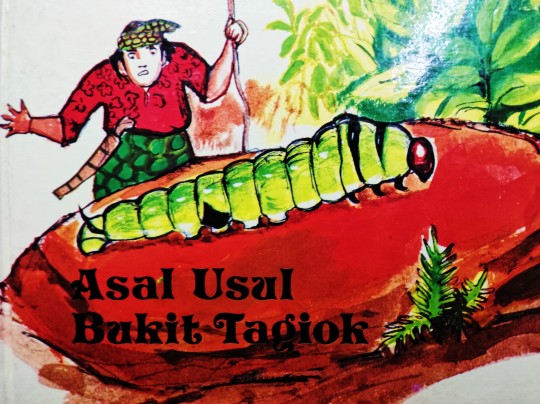
Published by Dewan Bahasa dan Pustaka Brunei in an unknown year. Written by Lamat Ja’afar. Story told by Tasim Lamat. Illustrated by Rahim Ahmad.
Bukit Tagiok is a hill that’s believed to be the source of rivers in Brunei hundreds of years ago during a great drought that turned the land a brick shade of red. The drought was called ‘The Nine Year Drought’ (Kemarau sembilan tahun) and water was severely scarce to the point that many hills turned into volcanoes. A name dropped in this book is Bukit Tabor Bintang- a hill that was previously a volcano until rivers started flowing. Geographically, Brunei does not have volcanoes and though our lands are hilly, volcano formation is unlikely to happen but I want to point out something interesting and my own little theories.
The 9-year-long drought reduced the water source of the whole country to one single well in Kampong Manggis. The height of the water is less than one’s ankles and its situated at the far bottom of the well. Seven different ladders, tied together at each end had to be use for the villagers to climb up and down. Usually they would queue up but knowing Bruneian’s haughty, selfish and petty behavior, fights that end up with killing happened a lot over water. Every single day. With the glaring heat and a large body count of people, the living, plagued in fatigue merely piled the dead bodies on top of one another and covered them in buckets of dirt to make the buriers less guilty. These poorly made graves turned into hills over time. The two greater hills were called Pungsu Timbunan and they’re the closest to the well as that’s where the killing usually happened.
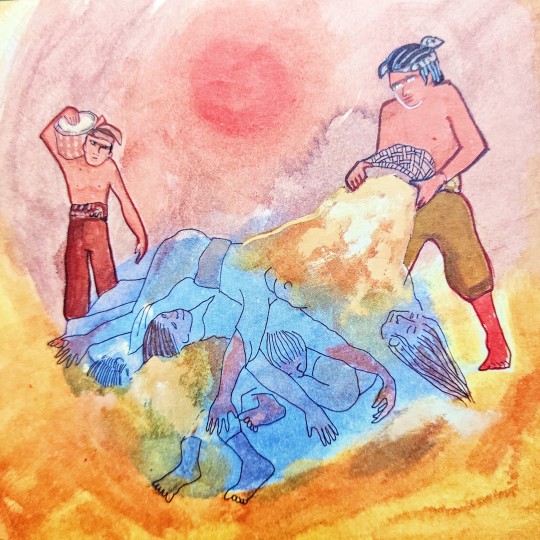
After some time, a Chinese man appeared with a jambol (a kinda haircut) and in his hand was a hammer and a nail thing. Curious on what this stranger was doing in their bare Malay lands, the villagers watched him place the nail at the base of a hill and hammer away. Water flooded out of the base of hill to the low lands to create a river. The Malays were overjoyed and their life prospered because, just like the current events, it is China that helped this struggling nation.
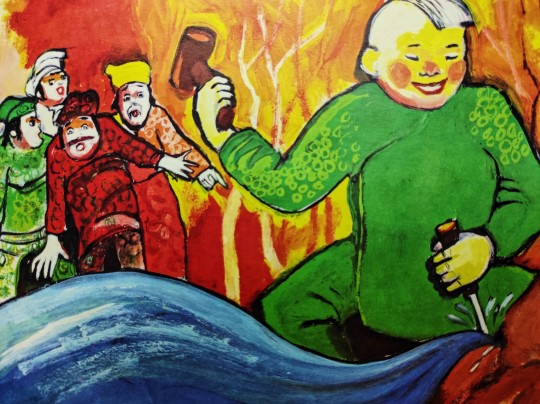
The Chinese man disappeared and now, the villagers, faced a even bigger dilemma; the water kept rushing in non-stop that the lowlands are the riverbeds and the highlands are the new lowlands. Sharks, crocodiles and other ocean creatures migrated to the river, namely Sungai Damaran via a channel in Sungai Mangsalut. The Chinese man, who the locals fondly call ‘Kina Bejambol’ appears, no emotions in his face and put a giant-ass rock at the hill opening. The flood stop and our hero vanished again. After some time, the villagers found a giant caterpillar resting on the flat rock of the hill base and decided to name the hill after the caterpillar instead of the man who literally saved the whole country. The Tagiok in Bukit Tagiok derived from the Bruneian word ‘giok’ which means caterpillar.
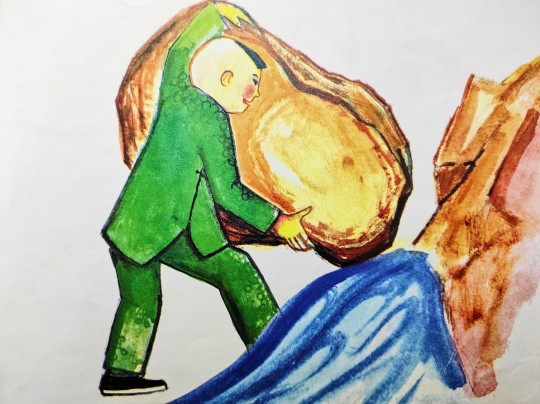
Fun fact: the rock Kina Bejambol used was flat so it’s called Batu Betilam. It’s believed that if you knock on it hard enough, it’ll sound hollow, like a well full of water. I’m not entirely sure if you can find the hill in modern day as putting ‘Bukit Tagiok’ on Waze had no results. But! Sungai Mangsalut and Bukit Tabur Bintang does exist in current day!


Perhaps, this story is based on real events- which brings me to:
THEORY TIME
The drought lasted for 9 years and there was no mention of a Sultan. My first theory was that the story took place in the era of the Bruneian Civil War that lasted for about 13 years. The same war that started over a cockfight and two sultans were fighting over the throne. With constant war, rations are low and the drought could just be symbolizing the dread, danger and neglect the people feel amidst war. Sabah during the time was under Brunei, so Sabah’s Mount Kinabalu’s name origin being from the word ‘Aki Nabalu’ – the revered place of the dead is such a coincidence with the Pungsu Timbunan in the story. Maybe their hill is made of piles of dead bodies too?

But that doesn’t match up. Mount Kinabalu has many origins, particularly involving widows and there isn’t a mention of a widow in this book. The events could not have happened during the Bruneian Civil war as its mentioned in history how one of the Sultans fled to Pulau Chermin, stuffed the royal crown and jewelries into a canon and shot it into the ocean where it remained lost. Water existed and Brunei back then wasn’t a barren land as chickens were healthy and used for cock fights- if there was a severe drought then, no one would have time to fool around with gambling with chickens.
This brings me to my second theory: the story took place wayyyyy longer in time. Before the first recorded sultan, Sultan Muhammad Shah came to the picture and Brunei back then, was ruled by an unknown chief who wasn’t Muslim. It’s noted from far back that Brunei, through different names had very close relationships with China so that might explain why our Chinese hero came to be. This makes sense cause, historically, Awang Alak Betatar (Sultan Muhammad Shah’s name before embracing Islam) and his siblings and crew screamed “BARU NAH” (‘There!’) on a SHIP meaning water was already present in the river canals.
But this doesn’t match up either because Kampong Manggis was mentioned in the story. There isn’t any historical records mentioning when Kampong Manggis was called Kampong Manggis. I don’t have info but the fact it’s only called Kampong Manggis instead of something more archaic sounding like, Tabur Bintang, Pandai Besi, gives me the impression that Kampong Manggis is a relatively new Kampong established in modern Brunei. I can’t even recall a folk story involving the kampong too so until further info is available, both my theories of this story is flawed.
Before I end this blog post, I wish to share that I am certain that his story isn’t a silly made up story like Dayang Dengan Timun because of the insert at the very first page by the director:

In today's wave of modern society, views are not always focused on one impression. The separation gap is too obvious, when the view is absorbed from the ideals of intellect and the mind is not limited to certain norms.
The natural response is to say that all folk tales are mere fairy tales, and are not suitable and in accordance with the current state of society. This response is very detrimental. This loss is not for individuals, but for all who are entitled to it.
Folklore has a distinctive position in literature. Its role is no less important than other ancient literary works. Disclosure of stories in the form of history, education, prominence and others in the form of books, is a practical and effective method.
This series of folk tales is rewritten from the speeches of the elders. Through cultural acculturation it is not impossible that these folk tales have similarities with the folk tales in this archipelago. The treasury of these folklore will be a ristaan and a point of reference for future generations who will most likely not hear these folk tales spoken by the elders. By recording these folk tales directly can also curb the extinction of these stories from disappearing just like that.
It is hoped that, in accordance with its potential as reading material, this book is suitable for additional reading of children in particular and adults in general.
This is one of the many local stories unheard of by not only my generation but my father’s too. It is by luck they managed to turn this into a book but it makes me wonder of the rest that are gone forever. This also means that any theory I throw on whether or not this event actually happened will not come to life because of this country’s lack of records in their own history (and uh, censorship. Lots of history have been omitted out of textbooks to disappear for good).
1 note
·
View note
Photo


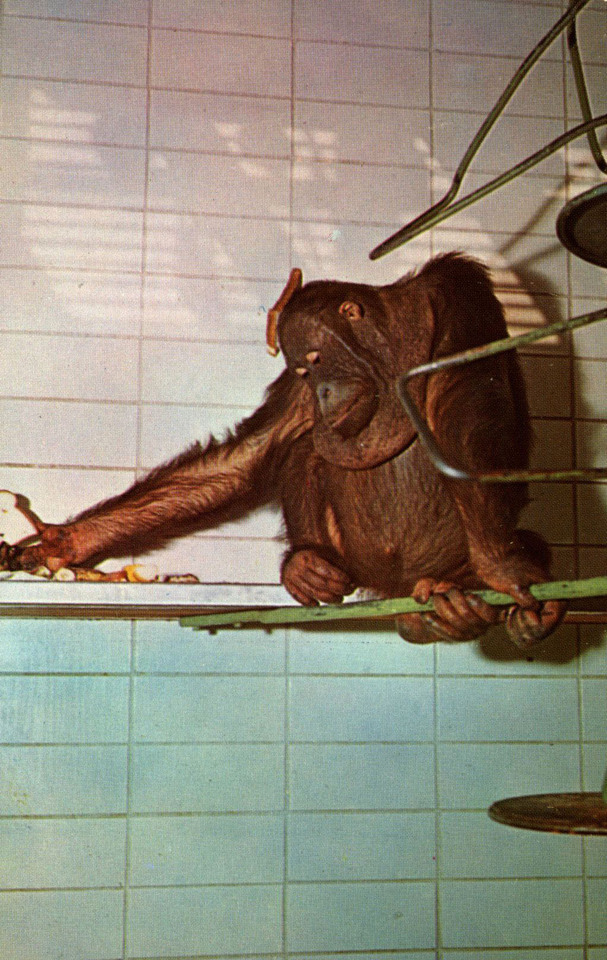
Endangered Species Day (May 17)
Every day, countless species come closer and closer to extinction. On this Endangered Species Day, we think about these animals and the organizations around trying to curb such extinctions.
The first photo, and my personal favorite, is of two Bengal Tigers (Panthera tigris tigris). Tigers are classified as endangered by the International Union for Conservation of Nature (IUCN). Tigers face many threats in their natural environment, especially from humans, agriculture, and land development. The Milwaukee County Zoo is now home to Amur Tigers which are also classified as endangered by the IUCN.
The second photo is of two Western Lowland Gorillas (Gorilla gorilla gorilla). According to the IUCN, Western Lowland Gorillas are critically endangered with a decreasing population. Major threats to these Gorillas include poaching, disease (especially Ebolavirus), habitat destruction, and climate change.
Finally, the third photo shows an Orangutan. All three subspecies of Orangutans (Pongo pygmaeus, Pongo abelii, and Pongo tapanuliensis) are classified as critically endangered with decreasing populations by the IUCN. Major threats include habitat loss, illegal hunting, and climate change. In addition to Western Lowland Gorillas, Sumatran Orangutans, and Bornean Orangutans, the Milwaukee County Zoo is home to several endangered and critically endangered primate species.
This Endangered Species Day, visit the zoo, read about endangered species, and think about how you might be able to help. Conservation is a huge priority to both the Zoological Society of Milwaukee as well as the Milwaukee County Zoo. Education is an important element to any conservation effort, so be sure to check out their websites and visit the International Union for Conservation of Nature to learn more about endangered plant, animal, and fungi species as well as about the IUCN’s own conservation and education programs. Be sure to check out the Red List, where you can learn more about endangered species including their population, habitat, threats, and conservation actions.
Unable to make it to the zoo today? Check out the zoo’s Polar Bear, Amur Tigers, and Orangutans, among others, on their ZooView webcams.
The images above come from our Thomas and Jean Ross Bliffert Postcard Collection (UWM Mss 171) and feature postcards from the Milwaukee County Zoo. The collection consists of approximately 12,000 postcards from all over the world. Much of the collection is from Wisconsin, organized by county. Milwaukee postcards are further organized by subject – more animal postcards can be found with the County Zoo (Box 7, Volume 13). The rest of the collection is organized into non-Wisconsin US states and foreign countries.
-Samantha Dickson, Archives Graduate Intern
#uwm archives#milwaukee county zoo#zoological society of milwaukee#endangered animals#endangered species day#bengal tigers#gorillas#orangutans#international union for conservation of nature#iucn#thomas and jean ross bliffert#postcards#milwaukee postcards#zoo#animals#Samantha D
15 notes
·
View notes
Link
Excerpt from this ProPublica article:
Oil-palm trees look like the coconut-palm trees you see on postcards from Florida — they grow to more than 60 feet tall and flourish on the peaty wetland soil common in lowland tropics. But they are significantly more valuable. Every two weeks or so, each tree produces a 50-pound bunch of walnut-size fruit, bursting with a red, viscous oil that is more versatile than almost any other plant-based oil of its kind. Indonesia is rich in timber and coal, but palm oil is its biggest export. Around the world, the oil from its meat and seeds has long been an indispensable ingredient in everything from soap to ice cream. But it has now become a key ingredient of something else: biodiesel, fuel for diesel engines that has been wholly or partly made from vegetable oil.
Our driver, a 44-year-old island native and whistleblower named Gusti Gelambong, had brought us here to show us the incredible destruction wrought by the growing demand for palm oil.
Most of the plantations around us were new, their rise a direct consequence of policy decisions made half a world away. In the mid-2000s, Western nations, led by the United States, began drafting environmental laws that encouraged the use of vegetable oil in fuels — an ambitious move to reduce carbon dioxide and curb global warming. But these laws were drawn up based on an incomplete accounting of the true environmental costs. Despite warnings that the policies could have the opposite of their intended effect, they were implemented anyway, producing what now appears to be a calamity with global consequences.
The tropical rainforests of Indonesia, and in particular the peatland regions of Borneo, have large amounts of carbon trapped within their trees and soil. Slashing and burning the existing forests to make way for oil-palm cultivation had a perverse effect: It released more carbon. A lot more carbon. NASA researchers say the accelerated destruction of Borneo’s forests contributed to the largest single-year global increase in carbon emissions in two millenniums, an explosion that transformed Indonesia into the world’s fourth-largest source of such emissions. Instead of creating a clever technocratic fix to reduce American’s carbon footprint, lawmakers had lit the fuse on a powerful carbon bomb that, as the forests were cleared and burned, produced more carbon than the entire continent of Europe. The unprecedented palm-oil boom, meanwhile, has enriched and emboldened many of the region’s largest corporations, which have begun using their newfound power and wealth to suppress critics, abuse workers and acquire more land to produce oil.
Lawmakers never anticipated that their well-intentioned plan — to help the climate by helping American farmers — might instead transform Indonesia and present one of the greatest threats to the planet’s tropical rainforests. But as Indonesian palm oil began to flood Western markets, that is exactly what began to happen.
23 notes
·
View notes
Text
The biography of a chocolate bar
(fieldwork #10)
• 1.) Chocolate Liquor: Cocoa beans with their shells removed that have been fermented, roasted and ground until they liquefy. This liquid is made up of cocoa butter and cocoa solids; both are naturally present in the bean.
• Cocoa Butter: Natural fat from the cocoa bean; extra cocoa butter enhances chocolate’s flavor and mouthfeel.
• Sugar
• Lecithin: An emulsifier, often made from soy, that makes the ingredients blend together.
• Vanilla or vanillin and other flavors.
• 2.) Chocolate is made from cocoa beans, the dried and fermented seeds of the cacao tree (Theobroma cacao), a small, 4–8 m tall (15–26 ft tall) evergreen tree native to the deep tropical region of the Americas.
3.) The process involves harvesting coca, refining coca to cocoa beans, and shipping the cocoa beans to the manufacturing factory for cleaning, coaching and grinding. These cocoa beans will then be imported or exported to other countries and be transformed into different type of chocolate products (Allen, 1994). Chocolate production starts with harvesting coca in a forest. Cocoa comes from tropical evergreen Cocoa trees, such as Theobroma Cocoa, which grow in the wet lowland tropics of Central and South America, West Africa and Southeast Asia (within 20 C of the equator) (Walter,1981) . Cocoa needs to be harvested manually in the forest. The seed pods of coca will first be collected; the beans will be selected and placed in piles. These cocoa beans will then be ready to be shipped to the manufacturer for mass production.
• 4.) Cocoa farmers´ low income leads to serious violations of human and labor rights on cocoa farms. Because of their poor income, farmers cannot pay sufficient salaries to the workers and provide them with acceptable accommodation and health care. Furthermore, workers and farmers are often exposed to hazardous working conditions: they handle pesticides without protective clothing, work with dangerous tools and have excessive working hours. They face gender and ethnic discrimination and suffer from poor nutrition. Communities lack access to education, drinking water and effective community management.
• 5.) Importers either sell the cocoa to buyers in the country where they are located or re-export them to other European countries. In most cases, importers have long-standing relationships with their suppliers. Around 90% of cocoa beans is produced by small farmers. Importers in the commodity segment handle large quantities and have contact with exporters in producing countries who are not necessarily cocoa farmers themselves. However, some importers deal directly with these producers and are specialized in dealing with smaller quantities, particularly in the specialty segment.
6.) While the profits of multinational chocolate companies have increased since the 1980s, the world market price for cocoa beans has declined by half (inflation-adjusted). Another part of the problem is that cocoa farmers receive only a part of the world market price for beans, due to local trading structures, taxes and also the quality of the beans. For example, over the last ten years farmers in the Ivory Coast attained only between 40 to 50 % of the world market price for their beans. Farmers are rarely organized and lack insight into market trends for cocoa prices. They have to sell their cocoa at prices dictated by the intermediaries.
• 7.) Hershey’s and march dominated the chocolate trade
• 8.) the government laws of the land
• 9.) Throughout history, chocolate has been marketed differently to different consumer types. Some companies like to show their customers that their chocolate has the most weight, by using digital scales and then showing what the price computing scales read on the actual package label. Yet, other companies prefer to create an upscale image, by making their products seem rich and indulgent. This article discusses the different ways to market chocolate.
• 10.) I bought my chocolate bar in Montebello
• 11.) the store owner usually makes 1/3rd of the retail price.
• 12.) According to the CNN Freedom Project, over 200,000 children are working in fields on the Ivory Coast to produce my favorite dessert. Some are earning a very meager paycheck to help support their families, while others are trafficked and sold to farmers for free labor. These children are typically between the ages of 12 and 16, but reporters have seen children as young as five. These kids work from six in the morning well into the evening, using chainsaws, machetes and knives to clear forests or cut down cocoa beans.
13.) Not all child work is considered labor, but a child cocoa laborer may be kept out of school to do physically harmful work, such as carrying heavy loads (often on the head), using dangerous tools such as machetes and handling harmful substances, such as pesticides. Despite efforts to curb it, child labor has only increased in recent years. In Ivory Coast, for example, child worker numbers in cocoa grew 51 per cent to 1.3 million between 2009 and 2014. Major chocolate manufacturers, under threat in 2002 of labelling legislation in the United States, promised to remove slavery from their supply chains by 2005. That stretched to 2008 and then 2010. A 2018 report on the $100-billion global chocolate industry claims that not a single company or government is anywhere near the current goal of reducing child labor by 70 per cent by 2020.
1 note
·
View note
Text
African Mountain Forests Store More Carbon Than We Thought But They're Vanishing Fast
https://sciencespies.com/environment/african-mountain-forests-store-more-carbon-than-we-thought-but-theyre-vanishing-fast/
African Mountain Forests Store More Carbon Than We Thought But They're Vanishing Fast
Tropical forests in Africa don’t receive nearly as much attention as the Amazon rainforest or the jungles of southeast Asia, but that says nothing of their overall importance in the global carbon cycle.
New research has shown the highest mountain forests in Africa can store more carbon per hectare than even the Amazon – far more than we assumed they were capable of.
“The results are surprising because the climate in mountains would be expected to lead to low carbon forests,” says tropical forest ecologist Aida Cuni-Sanchez from the University of York in the United Kingdom and the Norwegian University of Life Sciences.
“The lower temperatures of mountains and the long periods they are covered by clouds should slow tree growth, while strong winds and steep unstable slopes might limit how big trees can get before they fall over and die.”
But Africa seems to have trees unlike any other continent. Even under harsh mountainous conditions, researchers found numerous trees growing over 70 centimeters in diameter (28 inches), storing just as much carbon as lowland forests elsewhere in Africa and also in Borneo.
Unfortunately, these same old-growth forests are the ones cut down for logging, mining, and farming operations and due to political unrest. Since the turn of the century, at least 0.8 million hectares of mountain forest have been lost, mostly in the Democratic Republic of the Congo, Uganda, and Ethiopia.
According to the calculations of researchers, that’s equivalent to emitting over 450 million tons of CO2 into the atmosphere.
And in the next decade, if we do nothing to curb deforestation, the African continent could lose 0.5 million hectares more.
“Better understanding of montane carbon stocks is important for many African countries, particularly in eastern Africa where montane forests represent most of the extant evergreen old-growth forest cover,” researchers write.
“Quantifying carbon stocks in these ecosystems is critical for estimating national carbon losses from deforestation and forest degradation. Quantifying carbon stocks in old-growth montane forests also serves to constrain potential carbon uptake by restored natural forests… “
And yet, to date, very little research has been done on the ability of African forests to store carbon. In fact, the authors say data from African mountain regions is “exceptionally sparse.”
For instance, a 2019 update to the 2006 Intergovernmental Panel on Climate Change (IPCC) report gave old-growth forests in the mountains of Africa the same carbon-storing potential as secondary forests in other high-altitude regions, roughly 89 tons of carbon per hectare.
But that could be a major underestimation. In the new study, when researchers analyzed old-growth forests in 44 mountain sites across a dozen African countries, they found a carbon-storing potential of 150 tons per hectare – nearly two-thirds more than the IPCC report.
That’s pretty much on par with lowland forests in Africa, and both landscapes had low stem density and a high abundance of larger trees. This suggests the higher altitude does not impact the structure and carbon storage of Africa’s forests nearly as much as other areas in the world.
Although the authors found some variation in carbon storage between mountain forests, the differences were not related to elevation.
In fact, the authors found the tropical mountain forests of Africa stored about 70 percent more carbon on average than other mountain forests elsewhere in the tropics.
“While we know what makes African forests special, we don’t yet know why they are different,” explains Cuni-Sanchez.
“It is possible that in Africa, the presence of large herbivores such as elephants plays an important role in mountain forest ecology, as these large animals disperse seeds and nutrients, and eat small trees creating space for others to grow larger, but this requires further investigation.”
Today, 14 African nations have committed themselves to the Bonn Challenge, which seeks to restore 350 million hectares of deforested land by 2030 to combat biodiversity loss, local poverty, and climate change.
The new results suggest we must preserve forests both high and low, right across the continent to achieve this lofty goal.
The study was published in Nature.
#Environment
0 notes